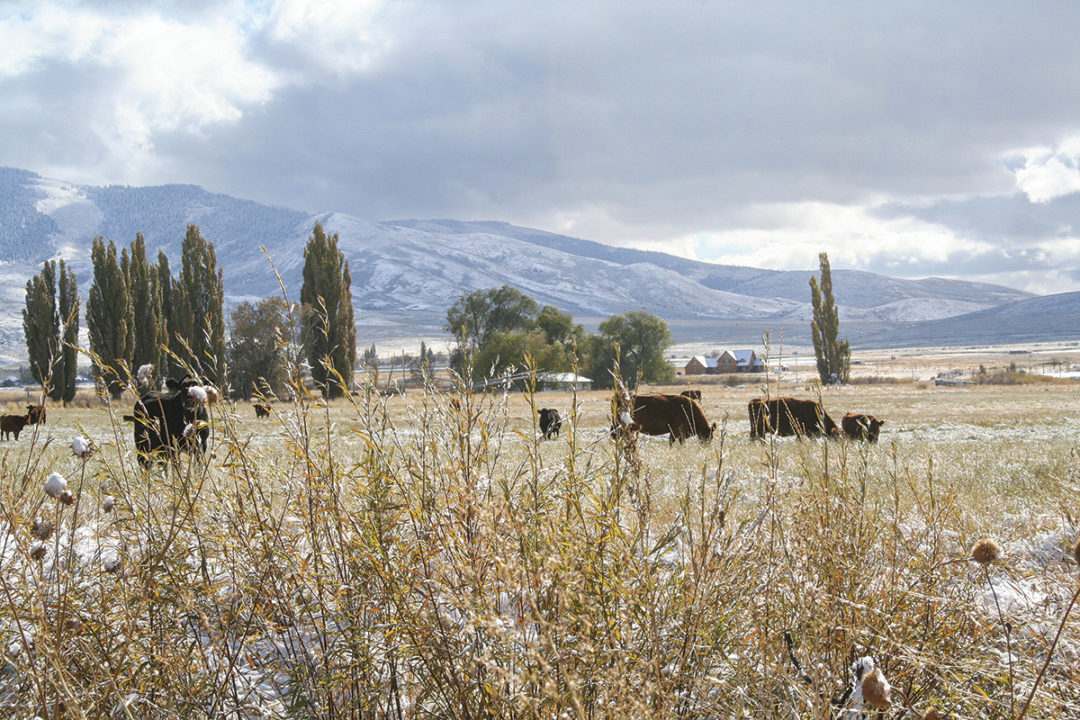A critical factor in determining the year-round carrying capacity of a ranch is winter grazing capacity.
One aspect of winter grazing capacity is annual precipitation and type of precipitation – rain, snow, ice, etc. Never use average annual precipitation to determine carrying capacity. Average precipitation only occurs 20% of the time, and 65% to 70% of the time most areas are below average.
The good years skew the average higher and result in overstocking due to unrealistic rainfall expectations when the average precipitation is used as the benchmark. Throw out the historical extreme highs and lows and determine a “normal” precipitation.
Most places in the U.S. can graze year-round with a little ingenuity and thought. Hay prices, fuel and equipment costs have risen to the point that many producers who choose to overstock their ranches and feed through the winter may be incurring costs of 14% to 20% of the total value of a bred cow for a 120-day feeding period.
Brood cows are a depreciating asset, and no business on the planet can sustain that type of annual expense on a depreciating asset just to sustain them through a third of the year. I have found it more profitable to decrease stocking rate and graze year-round with only supplemental feeding for protein needs and that occasional winter storm.
Winter grazing should greatly decrease the amount of hay fed, leaving carryover hay to sell in the spring, thus adding an additional income stream to the ranch. It is generally wise to have an emergency stock of forage stored for catastrophic events. Some considerations to consider in regard to winter grazing are:
1. Inventory winter forage on a regular basis. We must know how much standing and stored forage we have at all times.
2. Test winter forage to determine nutrient content, particularly protein, as in most areas this is the limiting winter nutrient.
3. Purchase protein supplements based on price per pound of protein plus what it costs to deliver supplement to the herd.
- For example, alfalfa with 20% protein costs 50 cents per pound of protein, whereas protein tubs/blocks currently cost $1.25 per pound of protein. This is cost of supplement only.
- If we supplement with alfalfa twice per week, it costs $600 per week in labor, equipment, fuel, etc., not including the cost of the alfalfa. Using protein blocks would cost $300 per week, as we only have to deliver a weekly supply of blocks to the herd.
- Based on a herd size of 500, alfalfa as a protein supplement reduces cost $2,325 per week during a 16-week supplement period. 500 cows x $0.50 per day (alfalfa) x 7 days = $1,750 per week supplement cost plus $600 per week for labor, fuel, equipment, etc. = $2,350 per week total supplement cost as compared to 500 cows x $1.25 per day (protein tub/block) x 7 days = $4,375 per week supplement cost plus $300 per week for labor, equipment, fuel, etc. = $4,675 per week total supplement cost.
Situations vary depending on calving date, distance to the herd, etc. Regardless of the situation, consider all costs of supplementing the herd – supplement itself, fuel, equipment, labor, etc. Sometimes what looks cheaper may not be when all costs are considered.
Just because something works for your neighbor doesn’t mean it will work the same for you. Do the math before making purchases or plans.
4. Heavier stocking density (smaller pastures, more cows per acre) with more frequent rotations will decrease protein costs as well as stretch pasture further through the winter.
Assume winter pasture tests 5% crude protein (CP). When cattle are first turned into the pasture, they will high grade the pasture for the best feed first. The first few days, their actual diet may be over 10% protein, which needs no supplementation in most cases, due to selection.
By the end of the graze period, cattle are grazing the dregs of the forage they left behind that could be as low as 2% to 3% protein. It is virtually impossible for cattle to maintain on this forage, regardless of supplementation level. This scenario should be avoided.
Through stocking more densely and decreasing winter pasture size, cattle are forced to more evenly graze forage, both good and poor quality, thus stretching pasture further and decreasing need for protein supplement.
Some ranchers even use electric fence to make daily moves in winter. In our situation, a three- to five-day rotation is the sweet spot for labor and ranch logistics. We utilize electric fence and move the fence farther away from the water source with each move.
Mapping apps such as Google Earth and OnX have great functions to allow you to determine acreages and where to build temporary fence for rationing purposes.
If you are forced to graze cattle for a longer period of time in a winter pasture, consider not putting any protein supplement out for the first quarter of the graze period, the normal ration for the middle two quarters and then double on the last quarter. This may serve to better match protein needs due to the selective grazing this plan allows.
Remember, each year is different and each ranch is different. There is no silver bullet or one-size-fits-all solution to winter grazing. Don’t be afraid to think outside the box, or better yet – throw the box away.








